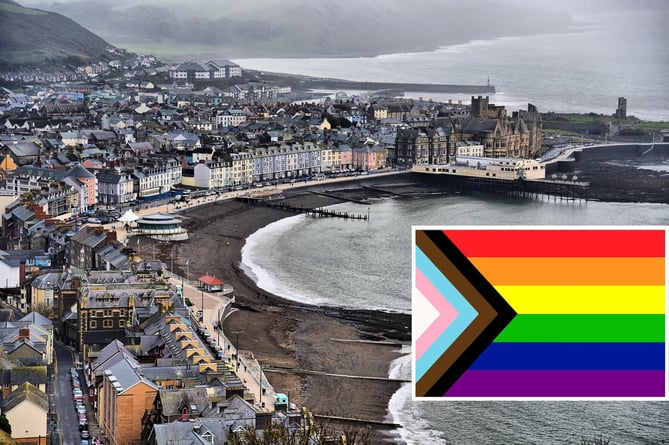Aberystwyth has finally been confirmed as the ‘gay capital of Wales’ after historic census data was released.
More than 16.5 per cent of people aged 16 or over in Aberystwyth North - which includes the university - recorded themselves as having an LGBTQ+ sexual orientation in the pioneering study.
It confirms long-held beliefs that the town boasts the most significant population of LGBTQ+ people in Wales. The findings were hailed by people on social media.
Ceredigion also has the highest concentration of people (0.7 per cent) - equal with Cardiff - aged 16 and over who identify with a gender identity different to their sex registered at birth.
The research by the Office for National Statistics (ONS) is the first authoritative dataset ever compiled into the sexual orientation and gender identity of people in England and Wales.
Aberystwyth North ranked above Bangor City and the Cardiff areas of Plasnewydd and Cathays South & Bute Park in the number of people who stated they were, what the ONS refers to as, LGB+ (lesbian, gay, bisexual or any other non-heterosexual sexual orientation). This is along with about 7 per cent of people in Aberystwyth South.
But the area with the most people identifying as specifically gay or lesbian is Cardiff Bay at 6.71 per cent, compared to 3.49 per cent in Aberystwyth North.
The census study into sexual identity found that 2.62 per cent of people in Aberystwyth North have a different gender identity than they were assigned at birth.
The local authorities with the largest LGBTQ+ populations in the country were Cardiff (5.3 per cent), Ceredigion (4.9 per cent) (or nearly 3,000 people), and Swansea (3.4 per cent).
Across Wales more than 1.5 per cent of the population or 748,000 people identify as gay or lesbian, and 624,000 or 1.3 per cent as bisexual.
Stonewall chief executive Nancy Kelly said: “For the past two centuries of data gathering through our national census, LGBTQ+ people have been invisible, with the stories of our communities, our diversity and our lives missing from the national record.
“Today is a historic step forward after decades of Stonewall campaigning to record sexual orientation and gender identity in the census, finally painting an accurate picture of the diverse ‘Rainbow Britain’ that we now live in, where more and more of us are proud to be who we are.”
The LGBT Foundation said the data is a 'huge first step in making LGBTQ+ people feel included' but added it will be years before the figures provide an accurate picture.
A spokesperson for the ONS said: “Ceredigion (4.9 per cent), Swansea (3.4 per cent), Gwynedd (3.3 per cent) and the Vale of Glamorgan (3.1 per cent) were the only other local authorities which had a higher proportion of people (than Cardiff) identifying with an LGB+ sexual orientation than the Wales average (3.0 per cent).
“The four local authorities with the highest proportion of people identifying with an LGB+ sexual orientation (Cardiff, Ceredigion, Swansea and Gwynedd) were also the four local authorities with the highest proportions of the population aged 16 to 24 in 2021.
“The proportion of people identifying as ‘Bisexual’ was largest in Ceredigion (2.6 per cent), Cardiff (2.4 per cent), Gwynedd (1.6 per cent) and Swansea (1.5 per cent).
“Ceredigion and Gwynedd were the only local authorities in Wales with more people identifying as “Bisexual” (2.6 per cent and 1.6 per cent respectively) than ‘Gay or Lesbian’ (1.5 per cent and 1.3 per cent respectively).
“The local authorities with the largest proportions of people choosing to write in their sexual orientations were Ceredigion (0.7 per cent) and Cardiff (0.5 per cent).
“In Ceredigion, 0.4 per cent of the population aged 16 and over identified as ‘Pansexual’, while in Cardiff this proportion was 0.3 per cent.
“The proportion of people aged 16 and over identifying as ‘Asexual’ was also highest in Ceredigion (0.2 per cent).
“’Queer’ was the most common write-in response after ‘Pansexual’ and ‘Asexual’ in Wales in 2021. The proportions of the population identifying this way were highest in Ceredigion, Cardiff and Gwynedd (0.1 per cent each).”
The census was compiled in England and Wales on 21 March last year and it is the largest study of its kind undertaken into the population of the England and Wales.




